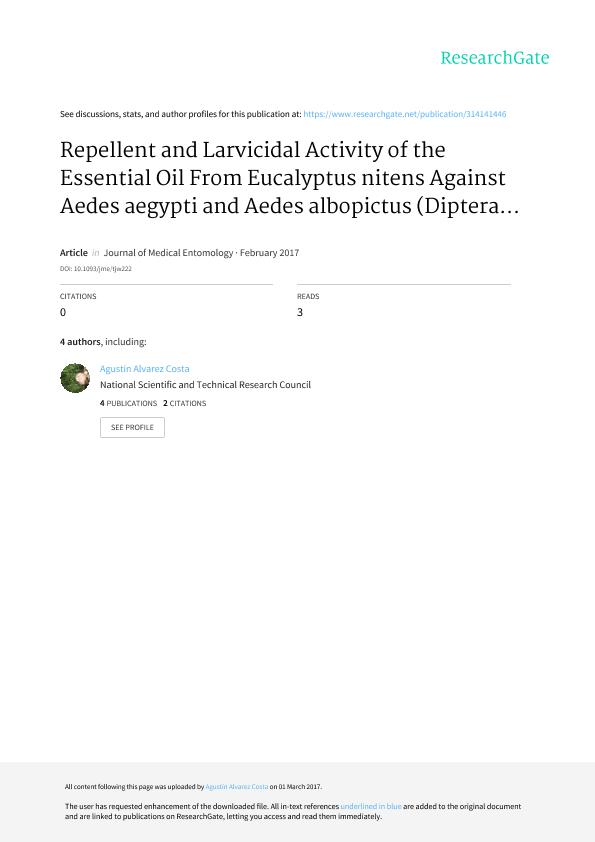Mostrar el registro sencillo del ítem
dc.contributor.author
Alvarez Costa, Agustin

dc.contributor.author
Naspi, Cecilia Veronica

dc.contributor.author
Lucia, Alejandro

dc.contributor.author
Masuh, Hector Mario

dc.date.available
2018-05-07T13:12:59Z
dc.date.issued
2017-01
dc.identifier.citation
Alvarez Costa, Agustin; Naspi, Cecilia Veronica; Lucia, Alejandro; Masuh, Hector Mario; Repellent and Larvicidal Activity of the Essential Oil From Eucalyptus nitens Against Aedes aegypti and Aedes albopictus (Diptera: Culicidae); Entomological Society of America; Journal of Medical Entomology; 54; 0; 1-2017; 670-676
dc.identifier.issn
0022-2585
dc.identifier.uri
http://hdl.handle.net/11336/44264
dc.description.abstract
Dengue, chikungunya, and yellow fever are important vector-borne diseases transmitted by female mosquitoes when they feed on humans. The use of repellents based on natural products is an alternative for personal protection against these diseases. Application of chemicals with larvicidal activity is another strategy for controlling the mosquito population. The repellent and larvicidal activities of the essential oil from Eucalyptus nitens were tested against Aedes aegypti and Aedes albopictus, the main vectors of these arboviruses. The essential oil was extracted by hydrodistillation and then analyzed by gas chromatography–mass spectrometry. The main components of Eucalyptus nitens essential oil were found to be terpenes such as 1,8-cineole and p-cymene, followed by β-triketones and alkyl esters. The repellent activity of the essential oil against both species was significantly higher when compared with the main component, 1,8-cineole, alone. These results indicate that the repellent effect of E. nitens is not due only to the main component, 1,8-cineole, but also that other compounds may be responsible. Aedes aegypti was found to be more tolerant to the essential oil larvicidal effects than Ae. albopictus (Ae. aegypti LC50 = 52.83 ppm, Ae. albopictus LC 50 = 28.19 ppm). The repellent and larvicidal activity could be associated to the presence of cyclic β-triketones such as flavesone, leptospermone, and isoleptospermone.
dc.format
application/pdf
dc.language.iso
eng
dc.publisher
Entomological Society of America

dc.rights
info:eu-repo/semantics/openAccess
dc.rights.uri
https://creativecommons.org/licenses/by-nc-sa/2.5/ar/
dc.subject
Eucalyptus Nitens
dc.subject
Repellent
dc.subject
Larvicidal
dc.subject
Aedes Aegypti
dc.subject.classification
Otras Ciencias Biológicas

dc.subject.classification
Ciencias Biológicas

dc.subject.classification
CIENCIAS NATURALES Y EXACTAS

dc.title
Repellent and Larvicidal Activity of the Essential Oil From Eucalyptus nitens Against Aedes aegypti and Aedes albopictus (Diptera: Culicidae)
dc.type
info:eu-repo/semantics/article
dc.type
info:ar-repo/semantics/artículo
dc.type
info:eu-repo/semantics/publishedVersion
dc.date.updated
2018-05-04T14:56:12Z
dc.journal.volume
54
dc.journal.number
0
dc.journal.pagination
670-676
dc.journal.pais
Estados Unidos

dc.journal.ciudad
Lanham
dc.description.fil
Fil: Alvarez Costa, Agustin. Consejo Nacional de Investigaciones Científicas y Técnicas. Unidad de Investigación y Desarrollo Estratégico para la Defensa. Ministerio de Defensa. Unidad de Investigación y Desarrollo Estratégico para la Defensa; Argentina. Consejo Nacional de Investigaciones Científicas y Técnicas. Instituto de Investigaciones Científicas y Técnicas para la Defensa. Centro de Investigación de Plagas e Insecticidas; Argentina
dc.description.fil
Fil: Naspi, Cecilia Veronica. Consejo Nacional de Investigaciones Científicas y Técnicas. Unidad de Investigación y Desarrollo Estratégico para la Defensa. Ministerio de Defensa. Unidad de Investigación y Desarrollo Estratégico para la Defensa; Argentina. Consejo Nacional de Investigaciones Científicas y Técnicas. Instituto de Investigaciones Científicas y Técnicas para la Defensa. Centro de Investigación de Plagas e Insecticidas; Argentina
dc.description.fil
Fil: Lucia, Alejandro. Consejo Nacional de Investigaciones Científicas y Técnicas. Unidad de Investigación y Desarrollo Estratégico para la Defensa. Ministerio de Defensa. Unidad de Investigación y Desarrollo Estratégico para la Defensa; Argentina. Consejo Nacional de Investigaciones Científicas y Técnicas. Instituto de Investigaciones Científicas y Técnicas para la Defensa. Centro de Investigación de Plagas e Insecticidas; Argentina
dc.description.fil
Fil: Masuh, Hector Mario. Consejo Nacional de Investigaciones Científicas y Técnicas. Unidad de Investigación y Desarrollo Estratégico para la Defensa. Ministerio de Defensa. Unidad de Investigación y Desarrollo Estratégico para la Defensa; Argentina. Consejo Nacional de Investigaciones Científicas y Técnicas. Instituto de Investigaciones Científicas y Técnicas para la Defensa. Centro de Investigación de Plagas e Insecticidas; Argentina
dc.journal.title
Journal of Medical Entomology

dc.relation.alternativeid
info:eu-repo/semantics/altIdentifier/doi/http://dx.doi.org/10.1093/jme/tjw222
dc.relation.alternativeid
info:eu-repo/semantics/altIdentifier/url/https://academic.oup.com/jme/article-abstract/54/3/670/3038210
Archivos asociados
